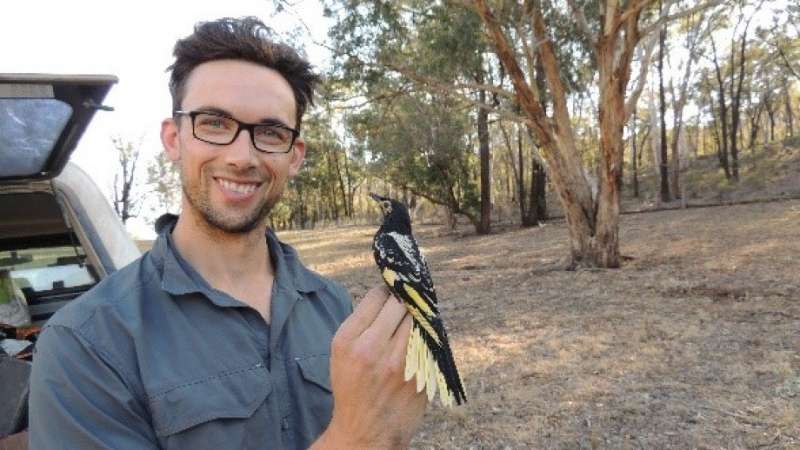Urgent action needed to help regent honeyeaters

Research led by the Australian National University (ANU) sheds new light on the rapid decline of the once-common regent honeyeater, offering new opportunities to help save the bird from extinction.
Lead researcher Ross Crates and his colleagues from the Difficult Bird Research Group at the ANU Fenner School of Environment and Society surveyed more than 5,000 sites between 2015 and 2017 to locate this extremely rare and highly mobile species.
Although regent honeyeaters were common as recently as the 1970s, only 350—500 regent honeyeaters survive in the wild. Between 2015 and 2018, the ANU team managed to locate between 70 and 150 adult regent honeyeaters each year. They even climbed trees to install surveillance cameras to monitor the nests of these difficult birds.
"We found 119 regent honeyeater nests over three years—more than we could ever have dreamed of," said Mr Crates.
"We found birds in the Capertee and Goulburn River valleys near Mudgee, the lower Hunter Valley near Cessnock and near Barraba in the Northern Tablelands. Importantly, we also found important new breeding areas in the Severn River in Northern New South Wales and the Burragorang Valley in the Southern Blue Mountains, south-east of Sydney."
The researchers found only one in three nests successfully produced offspring, down from one in two in the 1990s.
"Although breeding success appears to have declined, we found the survival of nests varied dramatically among sites. In some areas, 80 per cent were successful. In others, less than 20 per cent fledged young, with predators being the main cause of failure." Mr Crates said.
Habitat loss, habitat degradation and increases in the populations of nest predator species are thought to explain the decrease in breeding success.
The decline in the regent honeyeater population could also contribute to lower nest success. "Regent honeyeaters like to breed in groups. Historically, safety in numbers may have helped them defend their nests against predators but population decline has left them vulnerable."
The team also found there are more males than females left in the population, with one in six males unable to find a mate.
"Some poor males are singing non-stop to attract females that simply don't exist," Mr Crates added.
Although the current breeding figures are alarming, the Difficult Bird Research Group remains optimistic. The information obtained from this research is vital to help the regent honeyeater recovery team, including representatives from state and federal governments, the ANU, BirdLife Australia and Taronga Zoo, to improve the odds of saving the species.
"There are birds still out in the wild trying to breed every year. We now have a much better idea of where they are trying to nest and so we can focus on protecting and restoring the breeding habitat in critical places to directly benefit the birds."
The researchers warn urgent conservation action is needed, before it's too late.
"If we are to have any chance of saving regent honeyeaters from extinction, we must act now. We must protect all existing breeding habitat, restore lost breeding habitat and protect nests."
The research is published in the journal Ibis.
More information: Ross Crates et al. Contemporary breeding biology of critically endangered Regent Honeyeaters: implications for conservation, Ibis (2018). DOI: 10.1111/ibi.12659
Provided by Australian National University


















